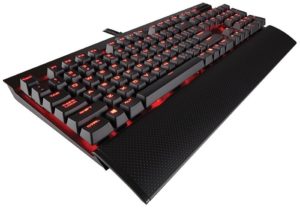The Mechanical Keyboard Shootout: Corsair vs. Roccat, Cherry & Rosewill
Introduction

Mechanical keyboards are all the rage these days, and while they’ve become popular with gamers looking to get an edge in competition, they are also sought out by professionals looking for more accuracy and feedback in typing. It’s no wonder that purists still covet the IBM Model M, a spring-based keyboard originally introduced way back in 1984. That’s because the heavy, responsive feel you get from a spring simply cannot be replicated in today’s membrane-based keyboards, which use a rubber dome in place of a spring. They’re quieter, cheaper, and lighter, which are all good things, but one thing membrane-based keyboards do not lend themselves to is actual typing performance.
So, is our only option to search around the web for IBM’s Model M relics? Of course not! Thankfully, several manufacturers have endeavored to bring back the crisp, chunky feeling of the mechanical keyboard, but sporting a number of modern updates. Perhaps best known among these purveyors of typing sensibility is Cherry, a company based in Germany that markets a whole range of mechanical switches, as well as complete keyboards and mice. We’ll be looking at several products featuring Cherry’s offerings, as well as one that has a lower-cost substitute. The goal is to give you a broad sense of what’s available, and what’s worth buying!
You can catch The Tech Buyer’s Guru in a humorous demo of several of the mechanical keyboards in this article, as aired on the March 15, 2017 broadcast of KGW-8’s Portland Today Show:
The Contenders
Here are the four keyboards we tested in this roundup:
- Cherry MX Board Silent – unavailable as or our publication date (thank you to Cherry for providing this review sample)
- Corsair K70 Lux MX Red – $109 as of our publication date (thank you to Newegg and Corsair for providing this review sample)
- Roccat Suora FX Brown – $123 as of our publication date (thank you to Roccat for providing this review sample)
- Rosewill RK-9300 BR – $90 as of our publication date (thank you to Rosewill for providing this review sample)
All four of these keyboards are mechanical in nature, but each has a slightly different switch inside. Cherry MX switches, by far the most popular mechanical switches on the market, are used in the Rosewill, Corsair, and obviously the Cherry keyboard, but even these are each quite different. You can see all the current Cherry switches in the display pictured below. We captured this image while chatting with Cherry representatives at CES 2017, and they were clearly excited about their expanding lineup of offerings.

The Corsair board uses what’s likely the most common switch, the linear, non-clicky MX Red. The Rosewill board uses the MX Brown switch, which adds tactile feedback. Interestingly, in what we believe is a cost-saving move, the Roccat uses a competitor’s switch, specifically the TTC Brown switch. These are far less common in the market, but as we’ll discuss later, they seem to work as well, at least in the short term. Long-term durability isn’t yet known.
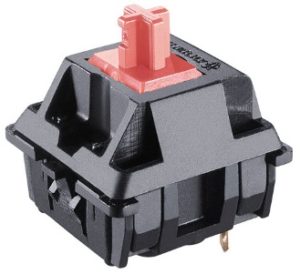
Finally, we get to the MX Red Silent switch, pictured here, which is in the Cherry-branded keyboard we’ve included in this roundup. The standard MX Red switch, released in 2008, is one of Cherry’s newer switches, and is marketed primarily at gamers. Cherry realized, however, that it’s lower noise output appealed to a number of users, and has now gone the extra step to convert the MX Red to a true office professional’s switch by giving it the “silent” treatment. Here’s what Cherry has to say about this switch:
patented (patent pending) noise reduction with integrated 2-component stem and worldwide unique Gold Crosspoint contact technology; minimises bottom-out and top out noise.
This switch is still hard to find in mainstream keyboards, and Cherry sent us a sample of their in-house silent model, simply dubbed the “MX Board Silent.” We’ll share our impressions later on, but there’s no doubt that the MX Red Silent switch used in this keyboard feels fundamentally different than any switch that’s come from Cherry previously. Note that the MX Board Silent isn’t available for sale in the U.S. as this time, but given that it’s basically a bog-standard white office keyboard modeled after products from the 1980s and 1990s, we view it mostly as a vehicle for testing these innovative new switches.
Test Setup
To get the most objective take on the contenders, we brought together two testers to try all of the products back-to-back, in the very same game: Battlefield 1.
Ari, TBG’s founder, used the following system:
- CPU: Intel Core i7-7700K Quad-Core
- Motherboard: Gigabyte GA-Z270X-UD3
- Memory: Corsair 2x8GB Vengeance LPX DDR4-3000
- Video Card #1: EVGA GeForce GTX 1070 SC 8GB
- Video Card #2: EVGA GeForce GTX 1070 FE 8GB
- Solid-State Drive: Samsung 850 Evo 500GB M.2
Alex, TBG’s lead web developer, used the following system:
- CPU: Intel Core i5-6600K Quad-Core
- Motherboard: Asus Z170-A
- Memory: Corsair 2x8GB Vengeance LPX DDR4-2666
- Video Card: Sapphire Radeon R9 Fury Nitro Tri-X OC+ 4GB
- Solid-State Drive: Crucial MX200 512GB
Using these high-end machines ensured that we could pick up on any flaws in the sample keyboards that led to missed keystrokes. Ari and Alex spent about two hours playing in the same online multiplayer matches, switching off peripherals after each round. Next, we’ll provide you more details on each of the contenders. We also tested out each keyboard for an extended typing session.
Description and Features
While in past years keyboard manufacturers tried to pile on the extra keys and features, we’ve seen a stunning reversal recently, with a trend towards minimizing footprints and complexity. Only one of the models we tested for this roundup includes a wrist rest and full media keys, namely the Corsair K70 Lux, shown below:
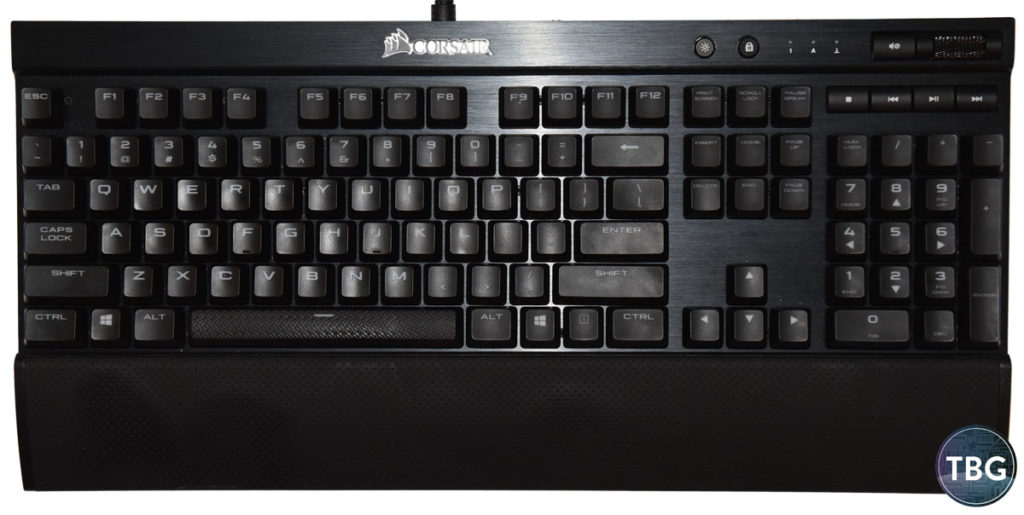
This wrist rest is quite comfortable and is also removable, which will please users who need a smaller footprint. Interestingly, with the wrist rest removed, the K70 is just 6.5″ deep, making it significantly smaller than every board in this review other than the Roccat Suora. In other words, it offers the best of both worlds. We really appreciate the dedicated media keys, especially the analog volume wheel, which is a really nice touch in an overly-digital world. Additionally, this is the only keyboard with a USB pass-through port, very hand very plugging in a USB mouse without having to reach behind your PC. The one strike against the Corsair design is that the wrist rest picks up palm prints over time, presumably from sweat and skin oils. You can see that even more clearly in the photo at the top of the next page, where these blemishes detract somewhat from the overall appearance. On a positive note, the Corsair K70 has by far the nicest frame, made of brushed aluminum. For what it’s worth, this keyboard clearly looks the most expensive, even if it’s not actually the most expensive.
As for the Cherry MX Board Silent, while it doesn’t have any dedicated media keys or really any special aesthetic features at all, it isn’t actually all that compact. That’s due to the dead space above the function keys – too bad the keyboard wasn’t shifted upwards to create a wrist rest. It does have a nearly 1″-thick frame, however, which does a nice job acting as a thumb rest. We actually found ourselves using the frame for just this purpose throughout our typing tests.
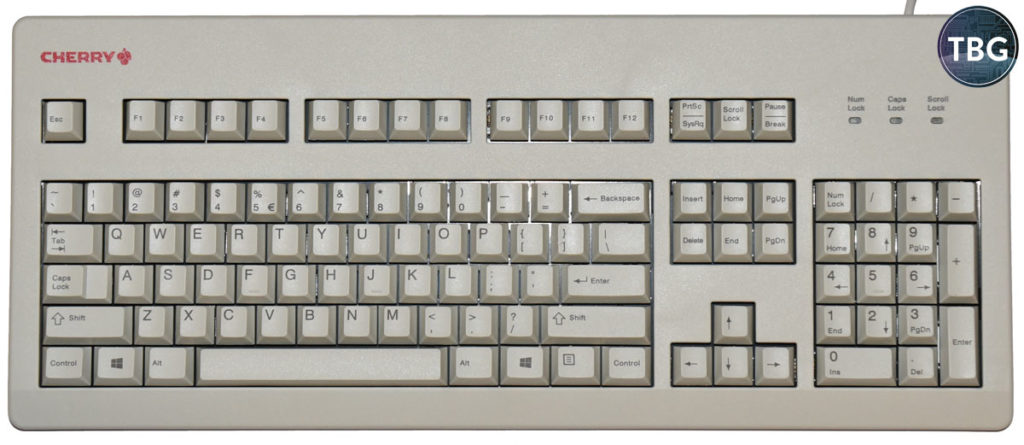
Next in terms of size we come to the Rosewill RK-9300, which has a pseudo-thumb rest below the bottom row of keys. It doesn’t function as well as a thumb rest as the frame on the Cherry because the keys float so far above the frame. Similar to all the models in this roundup other than the Corsair, the RK-9300 has no media keys, although it does have media functions mapped to its function keys. Disappointingly, the keycaps on this board are nearly impossible to read with the LEDs turned off, as you can see below. Unfortunately, due to the poor implementation of LED lighting on this board, this may be the preferred usage scenario. We’ll discuss that more on the next page. In another strike against the RK-9300, while it uses an aluminum backplate, the material looks surprisingly similar to plastic.
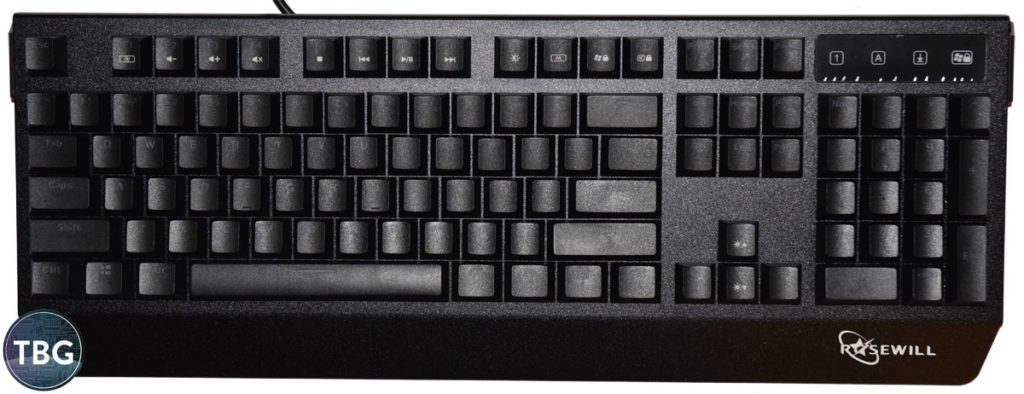
Finally, we come to the Roccat Suora (which, by the way, we have no idea how to pronounce). While we’ll discuss its ample lighting options on the next page, it’s actually the simplest board otherwise. It’s completely frameless, and thus has nowhere to rest your wrists or thumbs. The reason for the simple approach is that Roccat is appealing to gamers on the go, who need a compact board that will fit nicely in a backpack and on a crowded gaming desk. Thankfully, Roccat makes excellent use out of the space at hand, packing in three dedicated media keys (mute, volume down, and volume up) above the number pad. Note that it therefore needs to use color coding to indicate Caps Lock and other similar functions, which may disappoint users who’d like a cohesive color scheme throughout.

Now that you’ve read about what we consider the key design features of each product in this roundup, let’s move on to the actual real competition: the in-game performance!
Performance
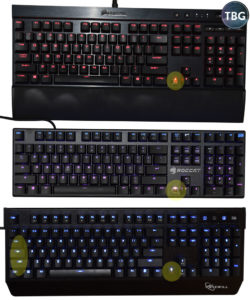
LED Lighting
Before we get into typing performance, we’re going to touch upon LED lighting. While backlighting has long been a desirable feature (especially in laptops), it’s now become something of a fad – the more lights and colors the better! The photo here shows three of our contenders, with the Corsair at the top, followed by the Roccat and the Rosewill. We’re showing off some of the lighting effects, and have highlighted a few items for your consideration. First, you can see we’ve removed one keycap on each board, which reveals the LED underneath. The LED lights are each placed above the switch, and generally look equally bright.
There’s more to backlighting, however, than just the placement of the LEDs. First, as you’ll see on the Rosewill board, the design of the keycaps can have a tremendous impact on the actual lighting effects. Unfortunately, the Rosewill keycap fonts are essentially transparent, meaning the light shines directly through. This is bad for a few reasons. First, it doesn’t evenly distribute the light across the keycap, as is clear from the word “Caps”, which looks faded on either end. But secondly, and more importantly, the light shines directly into the users eyes. Both of our testers immediately noticed this problem before taking a single keystroke. Frankly, it’s sort of amazing this passed the design stage. And given that there are no software controls for the lighting, you’re limited to controls via shortcut keys. They provide four levels of brightness (all too bright) or three alternate modes (breathing, tenkeyless lighting, and WASD/arrow lighting).
On the flipside, we have the fantastic Roccat Suora FX, which uses full per-key RGB backlighting, which can be programmed using the Roccast Swarm software. We’ve manually assigned different colors to each row of keys in this photo, starting with blue at the top and moving down to pink at the bottom. You can also have the Suora play back various pre-programmed effects, like a color wave, spirals, and other nifty if slightly distracting patterns. Most importantly for users, the Suora simply gives you choice, and we suspect most enthusiasts will be happy just picking one of millions of colors for their keyboard backlighting, whether it be a shade of green, blue, purple, red, or even white. One concern we had, however, is that the RGB lighting controller doesn’t seem to be as fast as the one we saw in the premium Corsair K70 RGB Rapidfire keyboard we previously reviewed. When an animated pattern was selected, there was noticeable choppiness, sort of like what you’d see on a monitor if the video output isn’t fast enough. We suspect that the Suora FX has a cost-reduced RGB controller.
The Corsair model being tested this time around doesn’t offer RGB lights, but otherwise is just as impressive as the K70 RGB Rapidfire we previously tested. When Corsair mysteriously introduced its new “Lux” line, many enthusiasts probably scratched their heads at what was different. Well, in reality, the most significant change was a very simple one, and it was done for the benefit of lighting: the font size was increased considerably, allowing much more light to be emitted through the keycaps. There’s no doubt it makes the keyboard quite easy to decipher, although the font is a bit less attractive than the one used on the Roccat, in our opinion. Note that Corsair’s CUE software allows you to take full control of the lighting on the K70 Lux, with features such as a raindrop effect (which lights up keys as you type them), as well as other crowd pleasers such as the wave. Ultimately, though, we feel users are going to spend a lot less time in CUE with a single-color LED keyboard than with RGB models.
Note that the Cherry MX Board Silent has just three LEDs, used for the Num Lock, Caps Lock, and Scroll Lock indicators. While Cherry does have LED-lit MX Silent keys, it’s not marketing them in its own keyboards.
The Keyboards In Use
While lighting is definitely a major selling point of several of these keyboards and will be factored into the rankings, ultimately you buy a keyboard to type on, game with, or both, so they have to perform in that regard. Both testers spent 30 minutes with each board typing and gaming, and came up with the following pros and cons for each model:
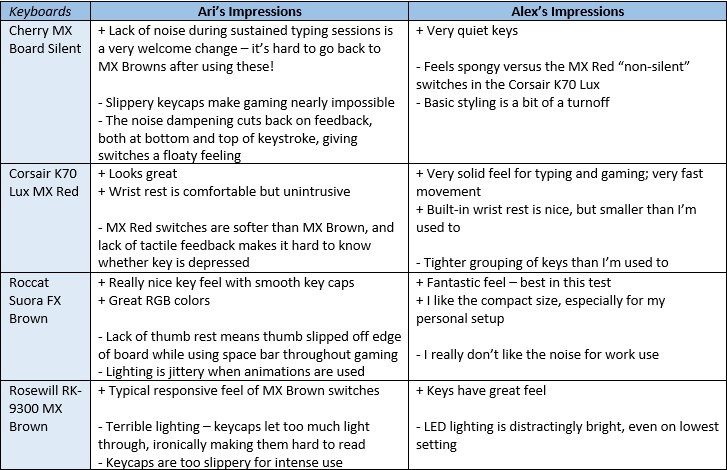
For gaming, Alex gave the nod to the Roccat Suora FX for its ultra-responsive feel. Ari agreed that it felt great, and in fact it might be a little crisper than the MX Brown switches in the Rosewill keyboard. Unfortunately, Ari thought the lack of a frame let alone a wrist rest made this keyboard distracting for gaming, as the space bar (which is used often in a lot of fast-paced games) was just too easy to slip off of. Therefore, Ari gave the nod to the Corsair K70 Lux. Had the Rosewill’s LEDs not been so terrible, it probably would have picked up a recommendation for gaming.
For typing, we were split on which model was the best. As much as Ari likes MX Brown switches for their enhanced feel, they are a little distracting to type on. Alex felt that MX Brown switches, as well as the TTC Brown clones in the Roccat, were great for gaming, but were just too loud to use for work, period. In the end, Ari would give the nod to Cherry’s MX Board Silent, but it did take some getting used to. It feels a bit spongy, but it’s quick, quiet, and comfortable, and when you’re really focused on typing, the lack of clicks is a pretty big benefit. It’s also the only option in a crowded office, or for users who frequently type while using the phone – all the other keyboards will be terribly distracting to people on the other end of the phone. Note that the floaty feeling of the MX Red Silent switches had us wondering if it’s actually any better than a membrane-based keyboard. Therefore, we pulled out a trusty Logitech model just to refresh our recollection of what they feel like, and wow, they’re mushy! Cherry may have “dumbed down” its MX Reds with the Silent treatment, but they are still leagues ahead of membrane key switches. That being said, in the end Alex decided none of these models was right for him, and went back to a membrane keyboard for his coding work, specifically the Roccat Skeltr.
Conclusion
With each keyboard offering a different take on the user experience, it’s hard to pick one clear winner. Let’s factor in price to see if we can come up with an overall winner. The Cherry MX Board Silent isn’t actually for sale yet, but Cherry informed us it would be around $150, which isn’t going to be palatable for most consumers. It’s just too plain. So it’s out of the running, but the MX Red Silent switches are definitely something you’ll want to consider if you’re an avid typist or need a keyboard appropriate for shared office use, and you can actually get an MX Silent keyboard for a great price today, ironically from Cherry’s partner Corsair. Indeed, Corsair’s Strafe MX Silent Keyboard is just $83 as of our publication date, making it a great value. Had that been included in the roundup, it may well have been a winner!
Between the other three models profiled in this article, the Rosewill RK-9300BR was the cheapest, and felt that way. The only thing it really has going for it are the MX Brown switches, but there are too many options at or around the same price that are better (including the excellent, bargain-priced G.Skill KM780 that won our previous roundup). That leaves the Corsair K70 Lux and the Roccat Suora FX. This is a really tough one, and it comes down to the form factor you prefer, as well as the importance of RGB lighting. In the end, we’re going to give the nod to the Corsair K70 Lux. It feels premium in every way, and can be purchased in a number of different configurations, including with RGB lighting and MX Brown switches, if you want to match the Suora’s setup. Yes, it costs more with an equivalent setup, but it feels worth it. While Roccat’s use of TTC switches doesn’t seem to negatively impact performance, the truth is that the Cherry MX name carries some weight when it comes to reliability and reputation. We also found that its RBG lighting controller was not as smooth as we would have liked. Furthermore, while its small footprint may be attractive to certain users, the lack of comfort and convenience features this necessitates also means it really must compete on price.
That’s all for now, folks. If you’re looking for all the latest and greatest in PC peripherals at every pricepoint, jump on over to our Peripherals Buyer’s Guide, updated quarterly with the best products on the market.


